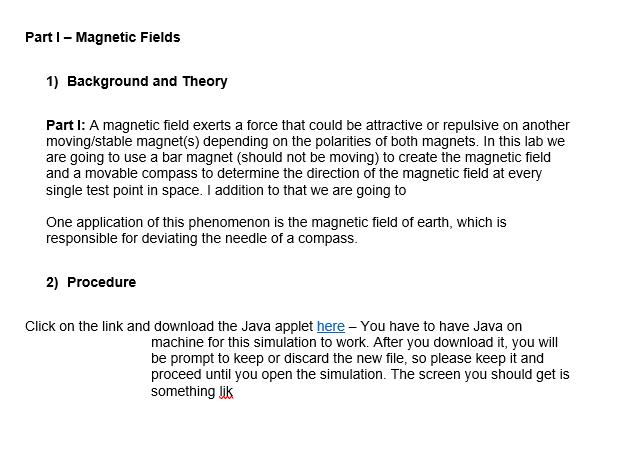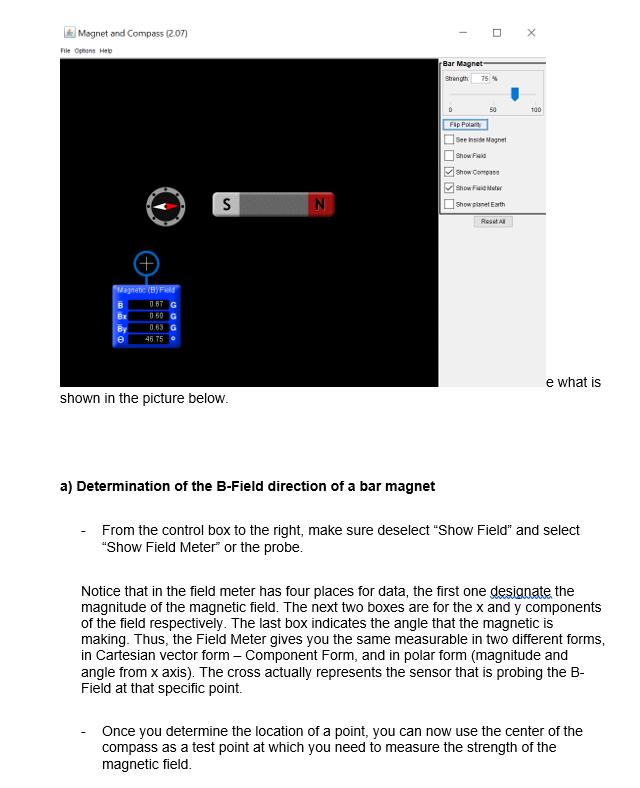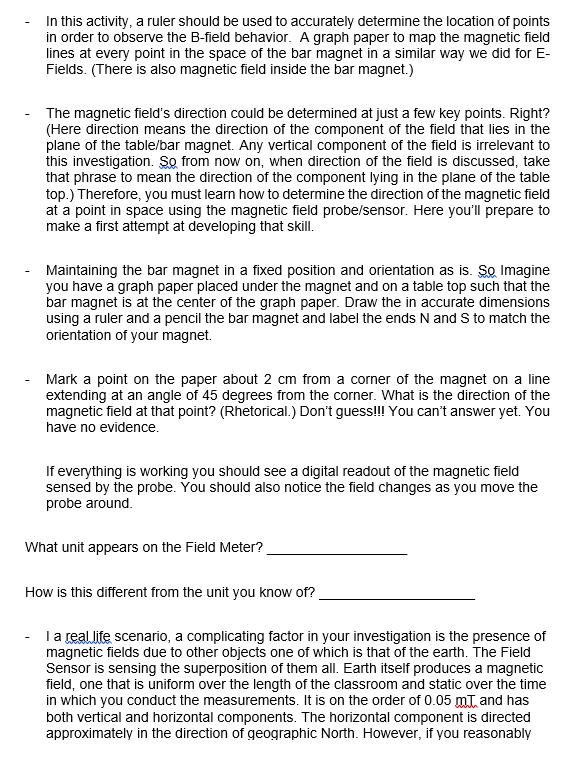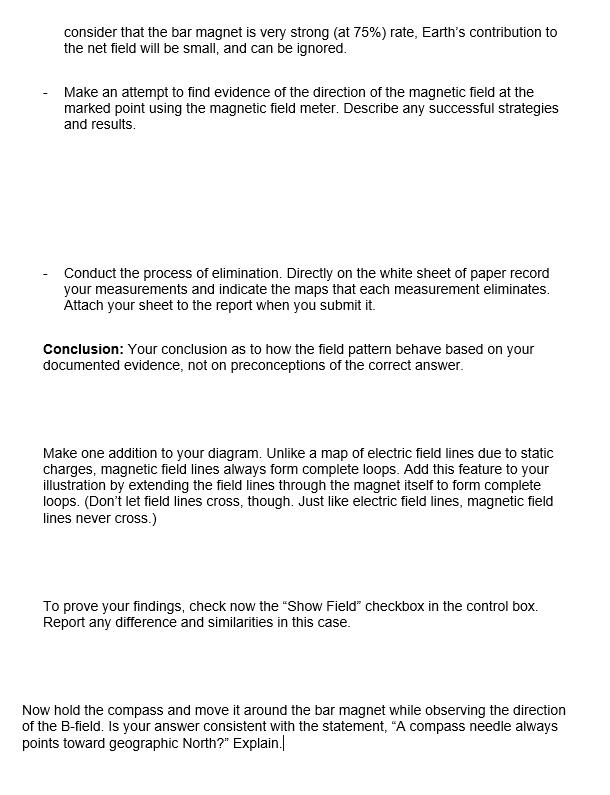Answered step by step
Verified Expert Solution
Question
1 Approved Answer
Part I - Magnetic Fields 1) Background and Theory Part I: A magnetic field exerts a force that could be attractive or repulsive on





Part I - Magnetic Fields 1) Background and Theory Part I: A magnetic field exerts a force that could be attractive or repulsive on another moving/stable magnet(s) depending on the polarities of both magnets. In this lab we are going to use a bar magnet (should not be moving) to create the magnetic field and a movable compass to determine the direction of the magnetic field at every single test point in space. I addition to that we are going to One application of this phenomenon is the magnetic field of earth, which is responsible for deviating the needle of a compass. 2) Procedure Click on the link and download the Java applet here - You have to have Java on machine for this simulation to work. After you download it, you will be prompt to keep or discard the new file, so please keep it and proceed until you open the simulation. The screen you should get is something lik Magnet and Compass (2.07) File Options Help Bar Magnet Strength 75% + Magnetic (B)Field B 067 G Bx 060 G By 0.63 G e 46.75 S shown in the picture below. 50 100 Fip Polan See Inside Magnet Show Fld N Show Compass Show Fid Meter Show planet Earth Reset All e what is a) Determination of the B-Field direction of a bar magnet From the control box to the right, make sure deselect "Show Field" and select "Show Field Meter" or the probe. Notice that in the field meter has four places for data, the first one designate the magnitude of the magnetic field. The next two boxes are for the x and y components of the field respectively. The last box indicates the angle that the magnetic is making. Thus, the Field Meter gives you the same measurable in two different forms, in Cartesian vector form - Component Form, and in polar form (magnitude and angle from x axis). The cross actually represents the sensor that is probing the B- Field at that specific point. Once you determine the location of a point, you can now use the center of the compass as a test point at which you need to measure the strength of the magnetic field. In this activity, a ruler should be used to accurately determine the location of points in order to observe the B-field behavior. A graph paper to map the magnetic field lines at every point in the space of the bar magnet in a similar way we did for E- Fields. (There is also magnetic field inside the bar magnet.) The magnetic field's direction could be determined at just a few key points. Right? (Here direction means the direction of the component of the field that lies in the plane of the table/bar magnet. Any vertical component of the field is irrelevant to this investigation. So from now on, when direction of the field is discussed, take that phrase to mean the direction of the component lying in the plane of the table top.) Therefore, you must learn how to determine the direction of the magnetic field at a point in space using the magnetic field probe/sensor. Here you'll prepare to make a first attempt at developing that skill. Maintaining the bar magnet in a fixed position and orientation as is. So Imagine you have a graph paper placed under the magnet and on a table top such that the bar magnet is at the center of the graph paper. Draw the in accurate dimensions using a ruler and a pencil the bar magnet and label the ends N and S to match the orientation of your magnet. Mark a point on the paper about 2 cm from a corner of the magnet on a line extending at an angle of 45 degrees from the corner. What is the direction of the magnetic field at that point? (Rhetorical.) Don't guess!!! You can't answer yet. You have no evidence. If everything is working you should see a digital readout of the magnetic field sensed by the probe. You should also notice the field changes as you move the probe around. What unit appears on the Field Meter? - How is this different from the unit you know of? I a real life scenario, a complicating factor in your investigation is the presence of magnetic fields due to other objects one of which is that of the earth. The Field Sensor is sensing the superposition of them all. Earth itself produces a magnetic field, one that is uniform over the length of the classroom and static over the time in which you conduct the measurements. It is on the order of 0.05 m and has both vertical and horizontal components. The horizontal component is directed approximately in the direction of geographic North. However, if you reasonably consider that the bar magnet is very strong (at 75%) rate, Earth's contribution to the net field will be small, and can be ignored. Make an attempt to find evidence of the direction of the magnetic field at the marked point using the magnetic field meter. Describe any successful strategies and results. Conduct the process of elimination. Directly on the white sheet of paper record your measurements and indicate the maps that each measurement eliminates. Attach your sheet to the report when you submit it. Conclusion: Your conclusion as to how the field pattern behave based on your documented evidence, not on preconceptions of the correct answer. Make one addition to your diagram. Unlike a map of electric field lines due to static charges, magnetic field lines always form complete loops. Add this feature to your illustration by extending the field lines through the magnet itself to form complete loops. (Don't let field lines cross, though. Just like electric field lines, magnetic field lines never cross.) To prove your findings, check now the "Show Field" checkbox in the control box. Report any difference and similarities in this case. Now hold the compass and move it around the bar magnet while observing the direction of the B-field. Is your answer consistent with the statement, "A compass needle always points toward geographic North?" Explain.| b) Determination of the magnitude of the B-Field 1. Based on your results from the previous activity, where did you find the object's magnetic field to be strongest, and how strong was it? If you found multiple points that were equally strong describe each point. 2. The strength of a magnetic field typically, although not always, varies from point to point. If the only information you have about a magnetic field is a map of field lines, how can you tell from the field lines alone where the field is strong and where it is weak? (If you are unsure, consider the data you have just collected. What feature of the field lines correlates with a magnetic field that you measured to be strong? In contrast, what feature of the field lines correlates with a magnetic field that you measured to be weak?). 3. Rank the points labeled A, B, C on the map below from strongest to weakest magnetic field. C 4. Given your answers to the previous questions, in the box below illustrate with field lines a magnetic field that is uniform in strength and direction. 5. The Earth's magnetic field at the surface of Earth is on the order of 5x10-5 T. A strong electromagnet might have a field of 1 T. The magnetic field produced by electrical signals in the brain, and measured with a technique called magnetoencephalography (MEG), is on the order of 10-12 T. Near the surface of a neutron star the magnetic field might be 108 T. In the table below rank these fields, along with the strongest measured field of your bar magnet, from weakest to strongest. Rank Weakest Source of field Strength of Field (T) Strength of Field relative to the earth's surface Field Strongest
Step by Step Solution
There are 3 Steps involved in it
Step: 1
Part 1 Magnetic Fields 1 Background and Theory Magnetic fields are regions where magnetic forces can be observed A magnetic field can exert a force that is either attractive or repulsive depending on ...
Get Instant Access to Expert-Tailored Solutions
See step-by-step solutions with expert insights and AI powered tools for academic success
Step: 2

Step: 3

Ace Your Homework with AI
Get the answers you need in no time with our AI-driven, step-by-step assistance
Get Started


